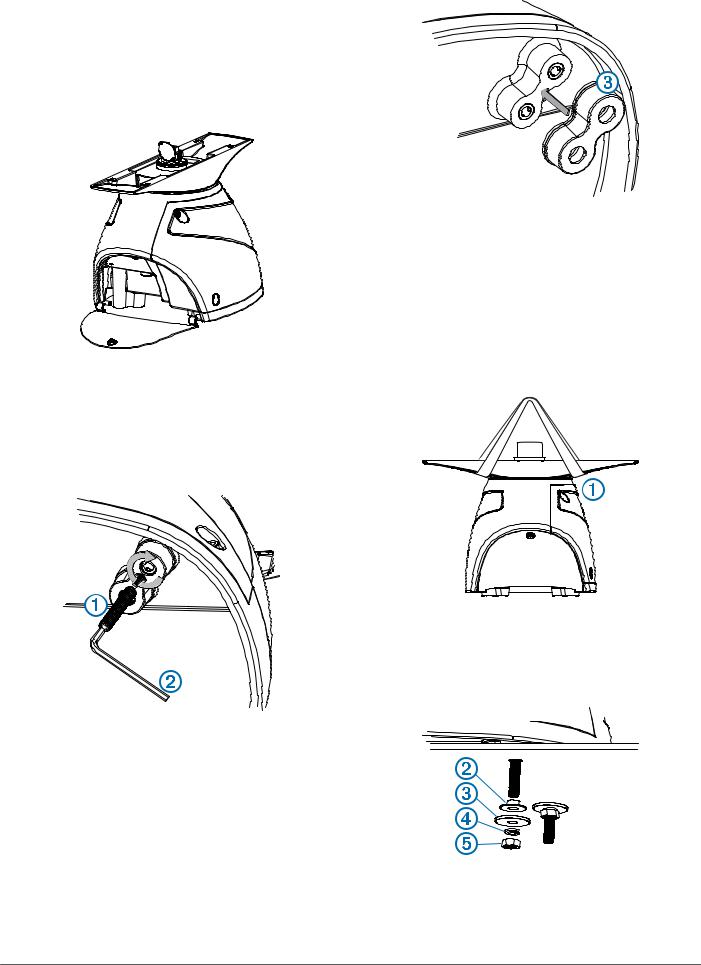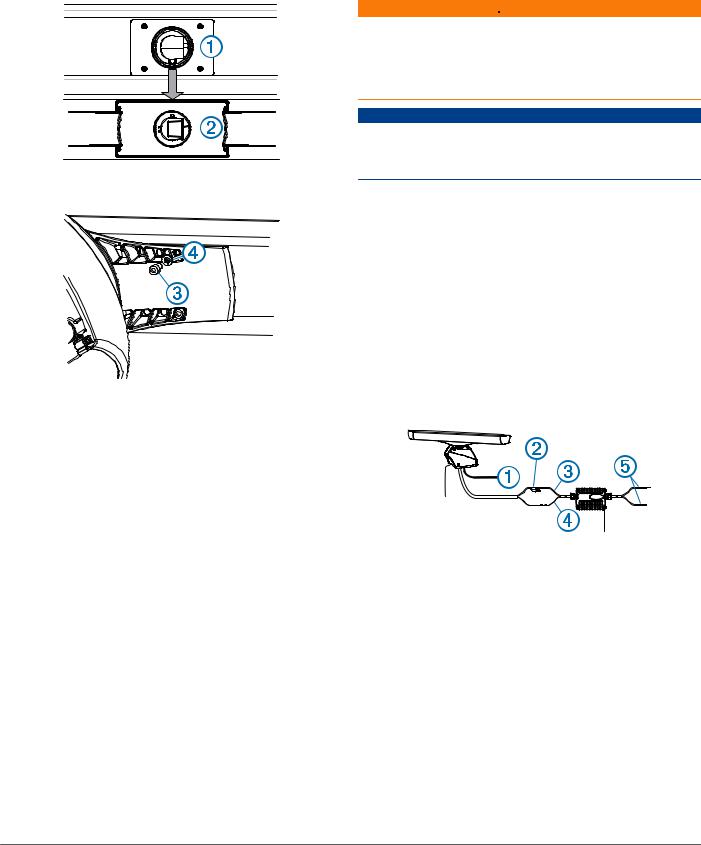Garmin GMR 1224 xHD2, GMR 1226 xHD2, GMR 18 xHD, GMR 424 xHD2, GMR 604 xHD Installation Instructions
...
GMR™ 420/620/1220 xHD2 Series
Installation Instructions
To obtain the best performance and to avoid damage to your boat, install the device according to these instructions.
Read all installation instructions before proceeding with the installation. If you experience difficulty during the installation, contact Garmin® Product Support.
Important Safety Information
 WARNING
WARNING
See the Important Safety and Product Information guide in the product box for product warnings and other important information.
The radar transmits electromagnetic energy. Ensure that the radar is installed according to the recommendations in these instructions and that all personnel are clear of the path of the radar beam before transmitting. When properly installed and operated, the use of this radar conforms to the requirements of ANSI/IEEE C95.1-1992 Standard for Safety Levels with Respect to Human Exposure to Radio Frequency Electromagnetic Fields.
When the radar is transmitting, do not look directly at the antenna at close range; eyes are the most sensitive part of the body to electromagnetic energy.
When connecting the power cable, do not remove the in-line fuse holder. To prevent the possibility of injury or product damage caused by fire or overheating, the appropriate fuse must be in place as indicated in the product specifications. In addition, connecting the power cable without the appropriate fuse in place will void the product warranty.
 CAUTION
CAUTION
This device should be used only as a navigational aid. Do not attempt to use the device for any purpose requiring precise measurement of direction, distance, location, or topography.
Always wear safety goggles, ear protection, and a dust mask when drilling, cutting, or sanding.
NOTICE
When drilling or cutting, always check what is on the opposite side of the surface.
Registering Your Device
Help us better support you by completing our online registration today.
•Go to http://my.garmin.com.
•Keep the original sales receipt, or a photocopy, in a safe place.
Contacting Garmin Product Support
•Go to www.garmin.com/support and click Contact Support for in-country support information.
•In the USA, call (913) 397.8200 or (800) 800.1020.
•In the UK, call 0808 2380000.
•In Europe, call +44 (0) 870.8501241.
Tools Needed
•#2 Phillips screwdriver
•5 mm hex wrench
•Drill and 15.0 mm (19/32 in.) drill bit
•17 mm (21/32 in.) wrench and torque wrench
•A length of 3.31 mm² (12 AWG) copper wire to ground the radar housing (and voltage converter, if applicable).
•Marine sealant
Mounting Considerations
When selecting a mounting location, observe these considerations.
•It is highly recommended that the device is mounted out of range of people, with the vertical beam width above head height. To avoid exposure to harmful radio frequency (RF) levels, the device should not be mounted closer to people than the maximum safe distance value listed in the product specifications.
•The device should be mounted high above the ship’s keel line with minimal blockage of the radar beam. Obstructions may cause blind and shadow sectors, or generate false echoes. The higher the installation position, the farther the radar can detect targets.
•The device should be mounted on a flat surface or a platform that is parallel to the vessel's water line and is sturdy enough to support the device's weight. The weight for each model is listed in the product specifications.
•The radar beam spreads vertically 11.5° above and
11.5° below the radar's radiating element. On vessels with
À
higher bow angles at cruise speed, the installation angle can be lowered to point the beam slightly downward to the waterline while at rest. Shims can be used if necessary.
•The device should be mounted away from heat sources, such as smoke stacks and lights.
•The device should be mounted at a different level than horizontal spreaders and mast crosstrees.
•To avoid interference with a magnetic compass, the device should not be mounted closer to a compass than the compass-safe distance value listed in the product specifications.
•Other electronics and cables should be mounted more than 2 m (6.5 ft.) from the radar beam path.
•GPS antennas should be either above or below the radar beam path.
•The device should be mounted at least 1 m (40 in.) from any transmitting equipment.
•The device should be mounted at least 1 m (40 in.) away from cables carrying radio signals such as VHF radios, cables, and antennas.
•The device should be mounted at least 2 m (6.5 ft.) away from Single Side Band (SSB) radios.
Preparing the Surface and the Radar for Mounting
Before you can mount the radar, you must choose a suitable mounting location (Mounting Considerations).
1Select an option:
•If you are using a pre-drilled Garmin compatible Furuno® or Raymarine® mount, proceed to step 3.
October 2014 |
Printed in Taiwan |
190-01818-02_0A |

•Secure the included mounting template to the surface at the chosen mounting location, along the bow-stern axis as indicated on the template.
2Determine which of the two mounting-hole patterns indicated on the template are appropriate for the mounting surface and drill the four mounting holes using a 15 mm (19/32 in.) drill bit.
3Remove the hatch on the front of the pedestal by loosening the screw and lifting it off of the hinges.
4Apply the included Petrolatum Primer to one half of the threads of the four threaded rods.
5Insert the ends of the threaded rods coated in Petrolatum Primer into the pedestal, matching the hole pattern chosen in step 2.
6 Tighten the threaded rods using a 5 mm hex wrench .
À Á
To avoid damaging the pedestal, you should stop tightening the threaded rods when they no longer turn easily.
7 Install the isolators over the threaded rods, and push them
Â
securely onto the four raised locations on the bottom of the pedestal .
Ã
Mounting the Radar
Before you can mount the radar, you must first select a mounting location, and prepare the mounting surface and the radar (Preparing the Surface and the Radar for Mounting).
1Take note of which end of the pedestal you plan to mount facing the bow along the bow-stern axis.
If the hatch side is facing the bow, you must adjust the front- of-boat offset on the chartplotter to receive an accurate radar reading (Front-of-Boat Offset).
2 Position the included strap over the antenna, as close to the pedestal base as possible .
À
3Hoist the radar into position, and carefully lower it onto the mounting surface, feeding the threaded rods through the holes.
4 From under the mounting surface, place the shoulder washers on the threaded rods and feed them into the
Á
mounting surface so they fit securely.
5 Place the flat washers , lock washers , and hex nuts
 à Ä
on the threaded rods.
6Torque the hex nuts to 1.5 kgf-m (130 lbf-in. [11 lbf-ft.]) to securely fasten the radar to the surface without damaging the radar or the mounting hardware.
2

Installing the Antenna
Before you can install the antenna on the radar, you must securely mount the pedestal (Mounting the Radar).
1Remove the protective cover from the waveguide on the top of the pedestal.
2 Align the waveguide on the pedestal with the socket on the
À
bottom of the antenna , and slide the antenna onto the
Á
pedestal.
3 Secure the antenna to the pedestal using the included hex bolts and spring washers .
ÂÃ
4Torque the hex bolts to 0.81 kgf-m (70 lfb-in. [6 lbf-ft.]) to fasten the antenna to the pedestal without damaging the antenna or the mounting hardware.
•The power cable should be installed as close to the battery source as possible.
◦If it is necessary to extend the power cable, the appropriate gauge of wire must be used (Power Cable Extensions).
◦Incorrectly extended runs of cable may cause the radar to malfunction due to insufficient power transmission.
Connecting to Power Through the Voltage Converter
 WARNING
WARNING
When connecting the power cable, do not remove the in-line fuse holder. To prevent the possibility of injury or product damage caused by fire or overheating, the appropriate fuse must be in place as indicated in the product specifications. In addition, connecting the power cable without the appropriate fuse in place will void the product warranty.
NOTICE
Do not reuse any voltage converters from previous Garmin radar models, or third party voltage converters. Using any converter other than one included with the radar may damage the radar or prevent it from turning on.
Some radar models require a voltage converter unit to properly power the device. If your model is packaged with a voltage converter, it must be installed in order for your radar to function. If your model is not packaged with a voltage converter, connect the power cable directly to the boat battery (Connecting Directly to Power).
When installing the voltage converter for an applicable radar model, observe these considerations.
•The voltage converter requires an input voltage of 10 to 32 Vdc.
•It is recommended to install the voltage converter as close as possible to the power source.
•Connecting the power cable for the voltage converter directly to the battery is recommended. If it is necessary to extend the cable, the appropriate gauge of wire must be used for the length of the extension (Power Cable Extensions).
Cable Considerations
It may be necessary to drill 31.7 mm (1 ¼ in.) holes for routing the power or network cable. The provided rubber cable grommet can be used to cover a cable installation hole.
•The grommet does NOT provide a waterproof seal. To make the grommet waterproof, marine sealant must be applied.
•If needed, the grommet can be trimmed to route both the power and the network cable through the same hole.
•Additional cable grommets can be purchased from Garmin or a Garmin dealer.
When installing the power and network cables, you should observe these considerations.
•Cutting the Garmin Marine Network cable is not recommended, but a field install kit can be purchased from Garmin or a Garmin dealer if cutting the network cable is necessary.
•To ensure safety, appropriate tie-wraps, fasteners, and sealant should be used to secure the cable along the route and through any bulkheads or the deck.
•Cables should not be run near moving objects and high-heat sources or through doorways and bilges.
•To avoid interference with other equipment, power and network cables should not be run next to or parallel to other cables, such as radio antenna lines or power cables. If this is not possible, the cables should be shielded with metal conduit or a form of EMI shielding.
Item |
Description |
|||||
À |
|
To the Garmin Marine Network |
||||
|
|
|
||||
Á |
|
7.5 A fuse holder |
||||
 |
|
Red (+) |
||||
|
|
|
||||
à |
|
Black (-) |
||||
|
|
|
||||
Ä |
|
To the boat battery (10 to 32 Vdc) |
||||
|
|
|
|
|
|
Water ground connection |
|
|
|
|
|
|
|
|
|
|
|
|
|
|
|
|
|
|
|
|
|
1Route the power cable to the radar and the voltage converter.
2Use crimp connectors and heat-shrink tubing to connect the power cable to the voltage converter.
The radar power cable contains a 7.5 A fuse which should not be removed when connecting to the voltage converter.
3Connect the voltage converter to the boat battery through a 15 A, slow-blow fuse (not included).
The 15 A fuse (not included) between the voltage converter and battery is in addition to the 7.5 A fuse included in the
3
